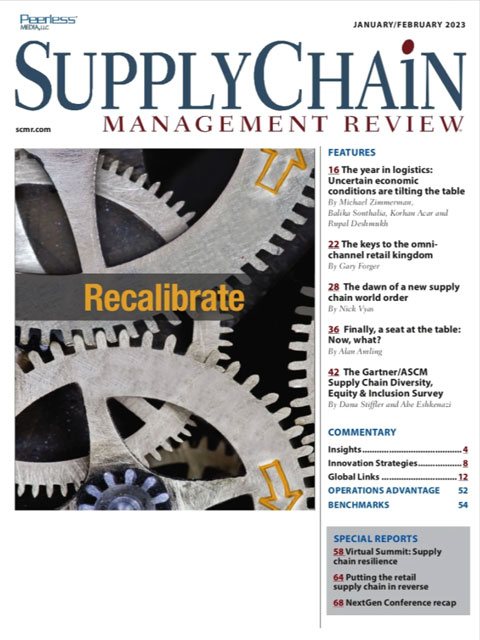Sorry, but your login has failed. Please recheck your login information and resubmit. If your subscription has expired, renew here.
January-February 2023
It feels like a normal holiday season. ”That was the report I got from the VP of global distribution at one of the country’s best known retail brands on the Monday before Black Friday. He added that the last time he felt that way was November of 2019. One of the perks of this job is that I get to talk to a lot of supply chain executives. In my conversations over the last year, I’ve learned two things. Operations, which was perhaps hardest hit at the start of the pandemic, has learned to operate in this new environment. Sure, there are still hiccups caused by absenteeism and inventory shortages. But those are situational—give them supply and… Browse this issue archive.Need Help? Contact customer service 847-559-7581 More options
It feels like a normal holiday season.”
That was the report I got from the VP of global distribution at one of the country’s best-known retail brands on the Monday before Black Friday. He added that the last time he felt that way was November of 2019.
One of the perks of this job is that I get to talk to a lot of supply chain executives. In my conversations over the last year, I’ve learned two things.
Operations, which was perhaps hardest hit at the start of the pandemic, has learned to operate in this new environment. Sure, there are still hiccups caused by absenteeism and inventory shortages. But those are situational—give them supply and people and operators will get stuff out the door.
Procurement and planning are still adapting. That’s because for them, the world is still an unsettled mess. It’s not just disruptions like Hurricane Ian or a shortage of containers. Increasingly, political instability is the cause of supply chain uncertainty. Think of how China’s continuing “zero COVID” policy is threatening a global recovery, or how Russia’s invasion of Ukraine has led to an increase in energy prices and commodities that are essential to food production. As of this writing, we in the United States still don’t know whether rail workers will go on strike; if they strike, will port workers be next?
More importantly, we’re seeing a realignment of trade agreements and relationships that may not have an impact today but could affect supply chains tomorrow.
It’s a new dawn for supply chain managers, one that is going to require us all to factor in geopolitics when we do our planning, and not just the cost of getting goods from Point A to Point B.
It’s time to recalibrate.
You can read more about this new dawn and the implication of politics on global supply chain management in an important article by Nick Vyas. But don’t stop there. In this issue, you’ll also find timely pieces on the future of omni-channel fulfillment, the outlook for logistics in 2023, how to enable organizational velocity in your company and the results of the Gartner/ASCM survey on diversity and inclusivity in the supply chain.
Last, I want to thank everyone who attended SCMR’s NextGen Supply Chain Conference in November. The event was live in Chicago, with presenters from companies as diverse as P&G, GE Appliances, Diageo, Estee Lauder and Kenco Logistics. We’re already planning the 2023 event, so keep an eye out in the spring for information on nextgensupplychainconference.com.
As always, I look forward to hearing from you.
SC
MR
Sorry, but your login has failed. Please recheck your login information and resubmit. If your subscription has expired, renew here.
January-February 2023
It feels like a normal holiday season. ”That was the report I got from the VP of global distribution at one of the country’s best known retail brands on the Monday before Black Friday. He added that the last time… Browse this issue archive. Access your online digital edition. Download a PDF file of the January-February 2023 issue.It feels like a normal holiday season.”
That was the report I got from the VP of global distribution at one of the country’s best-known retail brands on the Monday before Black Friday. He added that the last time he felt that way was November of 2019.
One of the perks of this job is that I get to talk to a lot of supply chain executives. In my conversations over the last year, I’ve learned two things.
Operations, which was perhaps hardest hit at the start of the pandemic, has learned to operate in this new environment. Sure, there are still hiccups caused by absenteeism and inventory shortages. But those are situational—give them supply and people and operators will get stuff out the door.
Procurement and planning are still adapting. That’s because for them, the world is still an unsettled mess. It’s not just disruptions like Hurricane Ian or a shortage of containers. Increasingly, political instability is the cause of supply chain uncertainty. Think of how China’s continuing “zero COVID” policy is threatening a global recovery, or how Russia’s invasion of Ukraine has led to an increase in energy prices and commodities that are essential to food production. As of this writing, we in the United States still don’t know whether rail workers will go on strike; if they strike, will port workers be next?
More importantly, we’re seeing a realignment of trade agreements and relationships that may not have an impact today but could affect supply chains tomorrow.
It’s a new dawn for supply chain managers, one that is going to require us all to factor in geopolitics when we do our planning, and not just the cost of getting goods from Point A to Point B.
It’s time to recalibrate.
You can read more about this new dawn and the implication of politics on global supply chain management in an important article by Nick Vyas. But don’t stop there. In this issue, you’ll also find timely pieces on the future of omni-channel fulfillment, the outlook for logistics in 2023, how to enable organizational velocity in your company and the results of the Gartner/ASCM survey on diversity and inclusivity in the supply chain.
Last, I want to thank everyone who attended SCMR’s NextGen Supply Chain Conference in November. The event was live in Chicago, with presenters from companies as diverse as P&G, GE Appliances, Diageo, Estee Lauder and Kenco Logistics. We’re already planning the 2023 event, so keep an eye out in the spring for information on nextgensupplychainconference.com.
As always, I look forward to hearing from you.
SC
MR


Latest Supply Chain News
- Joseph Esteves named CEO of SGS Maine Pointe
- Employees, employers hold divergent views on upskilling the workforce
- April manufacturing output slides after growing in March
- Q1 sees a solid finish with positive U.S.-bound import growth, notes S&P Global Market Intelligence
- World Trade Centers offers a helping hand to create resilient, interconnected supply chains
- More News
Latest Podcast

 Explore
Explore
Procurement & Sourcing News
- April manufacturing output slides after growing in March
- World Trade Centers offers a helping hand to create resilient, interconnected supply chains
- Bridging the ESG gap in supply chain management: From ambition to action
- Israel, Ukraine aid package to increase pressure on aerospace and defense supply chains
- How CPG brands can deliver on supplier diversity promises
- How S&OP provides the answer to in-demand products
- More Procurement & Sourcing
Latest Procurement & Sourcing Resources

Subscribe

Supply Chain Management Review delivers the best industry content.

Editors’ Picks





